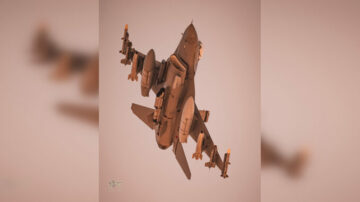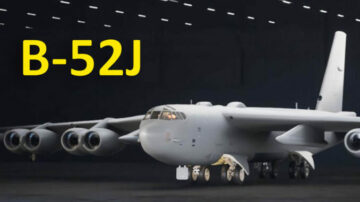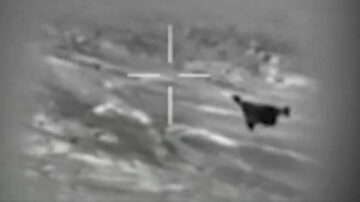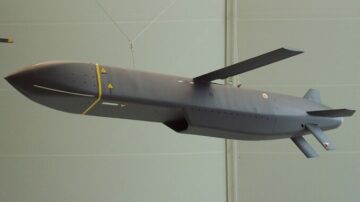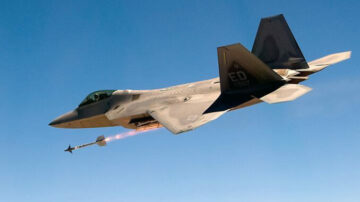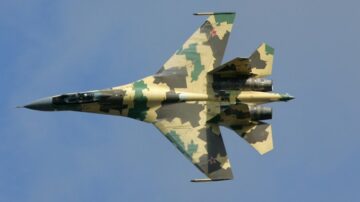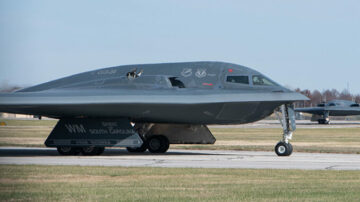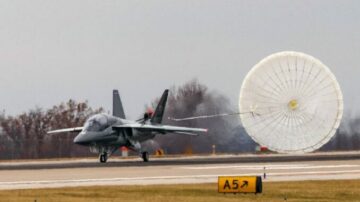
A new video shows a Russian missile releasing countermeasures during its terminal stage of flight.
On Mar. 22, 2024, Russia launched a large-scale missile and drone attack against Ukraine targeting Kharkiv, Zaporizhzhia, and Kryvyi Rih, primarily aiming at the Ukrainian energy infrastructure.
Zaporizhzhia’s Dnipro Hydroelectric Power Plant, Ukraine’s largest hydroelectric station, was among the targets hit by one the largest attacks on the Ukrainian energy sector in recent weeks.
Overnight, Ukrainian forces shot down 92 of the 151 russian aerial targets.
The terrorist state attacked Ukraine with:
•63 Shahed UAVs
•12 Iskander-M ballistic missiles
•40 Kh-101/Kh-555 cruise missiles
•5 Kh-22 cruise missiles
•7 Kh-47 M2 (Kinzhal) aeroballistic missiles… pic.twitter.com/orRb9pSd5I— Defense of Ukraine (@DefenceU) March 22, 2024
Among the videos shared online during and after the attack, one is particularly interesting, as it shows, once again, a Russian cruise missile approaching the dam and releasing countermeasures during the terminal stage of its flight.
🇷🇺🇺🇦 Footage from earlier this morning showing one of the Russian Kh-101 Air-Launched Cruise Missile which Struck the Dnipro Hydroelectric Power Station appearing to Deploy Flares before Impacting the Dam. pic.twitter.com/EtXhtUxfPm
— Spy (@TodayDefenceNew) March 23, 2024
Kh-101 air-launched cruise missiles are known to have been equipped with radio frequency countermeasures, commonly known as chaffs, since the beginning of 2023. This upgrade was discovered from the analysis of photos of Kh-101s’ wreckages, which showed the countermeasures dispensers.
In December 2023, a Kh-101 releasing flares to deceive Ukrainian air defenses during an attack was first filmed. The one on Mar. 22, would be the second time the use of countermeasures by a Russian cruise missile was caught on camera.
While the quality of the latest clip does not allow a proper identification of the missile, it seems likely it’s again a Kh-101.
Here’s a slowed down version of the same footage.
The russian rocket wich flew to the Dniprodam and blew up the dam. pic.twitter.com/m6AU5MnDMJ
— Sander (@SanderRegter) March 22, 2024
The Kh-101 is a fairly recently developed long range cruise missile roughly analogous to the U.S. Tomahawk family of cruise missiles, which was already employed in Syria during Russian Tu-95 and Tu-160 bomber strikes in 2016 and 2017. Eight Kh-101 cruise missiles can be carried by a Tu-95 bomber, while twelve can be carried by a Tu-160.
The Kh-101 cruise missile has an effective combat range of 2,790-3,000 miles (about 4,500+ kilometers) and can carry a variety of different warheads depending on the target to be struck. The missile is reported to have low-observable (“stealth”) characteristics and is capable of adjusting its targeting while in flight to the assigned target. The Kh-101 missile is, in fact, believed to use a combination of inertial guidance and satellite navigation using the Russian GLONASS system, with opto-electronic flight correction system. Its accuracy is reported as “within 10 meters”.
- SEO Powered Content & PR Distribution. Get Amplified Today.
- PlatoData.Network Vertical Generative Ai. Empower Yourself. Access Here.
- PlatoAiStream. Web3 Intelligence. Knowledge Amplified. Access Here.
- PlatoESG. Carbon, CleanTech, Energy, Environment, Solar, Waste Management. Access Here.
- PlatoHealth. Biotech and Clinical Trials Intelligence. Access Here.
- Source: https://theaviationist.com/2024/03/24/video-shows-russian-cruise-missile-release-decoy-flares-in-flight-during-dnipro-dam-attack/?utm_source=rss&utm_medium=rss&utm_campaign=video-shows-russian-cruise-missile-release-decoy-flares-in-flight-during-dnipro-dam-attack
- :has
- :is
- :not
- $UP
- 000
- 10
- 125
- 1996
- 2%
- 2016
- 2017
- 2023
- 2024
- 22
- 23
- 2nd
- 4
- a
- About
- accuracy
- adjusting
- After
- again
- against
- Aiming
- AIR
- Air Force
- aircraft
- allow
- already
- among
- an
- analysis
- and
- appearing
- approaching
- ARE
- AS
- assigned
- At
- attack
- attacked
- Attacks
- Australia
- avatar
- aviation
- based
- BE
- been
- before
- Beginning
- believed
- blogs
- Books
- Box
- by
- camera
- CAN
- capable
- carried
- carry
- caught
- combat
- combination
- commonly
- computer
- Computer Engineering
- contributed
- covering
- Crime
- cruise
- David
- December
- Defense
- defenses
- Depending
- deploy
- developed
- different
- discovered
- does
- down
- drone
- during
- Earlier
- editor
- Effective
- eight
- employed
- energy
- Engineering
- equipped
- Europe
- fact
- fairly
- family
- famous
- five
- flight
- For
- Force
- Forces
- Former
- founder
- Frequency
- from
- graduate
- guidance
- Have
- he
- Hit
- HTTPS
- Identification
- image
- impacting
- in
- Including
- industry
- Infrastructure
- Intelligence
- interesting
- IT
- Italian
- Italy
- ITS
- journalist
- jpg
- kilometers
- known
- large-scale
- largest
- latest
- launched
- likely
- Long
- M2
- magazines
- Main
- major
- many
- mar
- Military
- missiles
- monthly
- more
- morning
- most
- Navigation
- New
- of
- on
- once
- ONE
- ones
- online
- Others
- particularly
- photo
- Photos
- pilot
- Planes
- plant
- plato
- Plato Data Intelligence
- PlatoData
- power
- primarily
- private
- probably
- proper
- quality
- Radio
- range
- Read
- recent
- recently
- release
- releasing
- Reported
- rocket
- rome
- roughly
- Russia
- russian
- s
- same
- satellite
- Second
- sector
- seems
- several
- shared
- shot
- showed
- showing
- Shows
- since
- slowed
- Stage
- State
- station
- Strikes
- Syria
- system
- Target
- targeting
- targets
- Terminal
- terrorist
- The
- this
- time
- to
- u.s.
- Ukraine
- Ukraines
- Ukrainian
- upgrade
- use
- using
- variety
- version
- Video
- Videos
- war
- was
- Weeks
- which
- while
- with
- world’s
- worldwide
- would
- written
- zephyrnet


